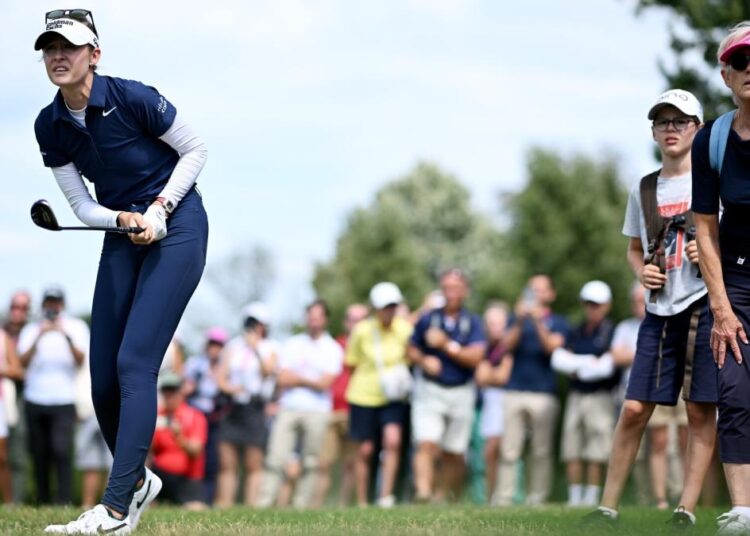The LPGA is at a tipping point.
The sentiment among those around the tour is that the environment is ripe for unprecedented growth and that opportunity is greater than in years past.
There are several reasons for optimism:
*Investment. Sports marketing budgets at companies continue to increase in the post-COVID boom. According to one report, sports sponsorship dollars were estimated to grow by 6% this past year, an increase of $4 billion.
*Global reach. The LPGA has increased its worldwide exposure over the last two-plus decades. Individuals – none greater than South Korea’s Se Ri Pak – have played a large role in this, but the tour has taken expansive steps. In 2006, it added Thailand to its schedule to create three – along with South Korea and Japan – Asia events. This past season, there were two separate swings and seven overall stops. There were also 14 active Thai players on tour, up from one, 20 years ago, as evidence of the impact.
The current top 10 in the Rolex Rankings include players from nine different countries on four different continents, opening the door for continued growth. And with 23% of the 2025 events in Asia, it provides Asian-based companies the chance to do business with the tour on home soil and offers the opportunity to increase North American exposure for those who want to buy into domestic events.
*Growth. The National Golf Foundation estimated 45 million Americans played golf, traditionally or non-traditionally, in 2023. It reported approximately 7 million on-course female golfers in 2023. The numbers continue to climb on and off the course. The LPGA epitomizes diversity and opportunity; there is no better time to grow the fan base.
*Engagement. According to a report, women accounted for 52% of college NIL marketing deals, just another example of how female athletes create value and can be used positively for marketing.
*Demographics. While the base is shifting, the golf consumer is still affluent and is one of the most desirable to advertisers. The LPGA and PGA Tour have a similar demographic and both provide an exclusive and aspirational brand association for corporate partners. The LPGA has the added benefit of being a value price tag for those who want to invest in golf sponsorship.
At this moment, with the right commissioner, the LPGA is in the middle of the fairway on a reachable par 5.
The key is finding the proper fit.
Malcolm Gladwell’s sociology book, “The Tipping Point,” theorizes that there are three important people needed to create social epidemics – turning a small fad into a social norm. In this case, a social epidemic would bring the LPGA into the mainstream sports conversation and break further into pop culture.
The three types of people involved in making that type of transformation are:
*Connectors. These are people with large social networks who can connect others across different circles. They are the glue that help spread social epidemics. An ideal commissioner candidate would be a relationship specialist. There are multiple personal and business relationships that need nurturing – and are less transactional – than other types of marketing. Sponsors get involved with golf for a different kind of experience, something they can’t get from other sports. The pro-am experience is beyond a front-row seat. It allows sponsors and partners to get to know the players, to see, up close, how talented they are, and to feel invested in the players and the event. And just how LPGA players are expected to engage and entertain, it is not unreasonable to expect the same of tour leadership.
*Mavens. These are the people who have expertise and a strong ability to communicate that information. The commissioner or key spokesperson will need a broad understanding of the business as it stands. The LPGA is unique because it owns some tournament properties, but the majority are run by tournament owners who have their own collection of sponsors and stakeholders. The television partnerships, Ladies European Tour, LPGA Foundation and the teaching branch are also important dynamics that need an experienced understanding. It’s not to say that an “outsider” wouldn’t be able to step in, but there will be a learning curve for them. There would need to be a trusted person with this broad comprehension so that the LPGA can immediately push forward without taking a pause or stepping back.
*Salesman. These are the persuasive and charismatic people who can influence others into action. Ultimately, the commissioner’s job involves selling the tour to the marketplace and being able to communicate the value proposition. It also includes selling a vision of the tour to the players. The player buy-in is critical to success and meaningful growth. This includes setting goals and being accountable to them. I have witnessed three LPGA commissioners, and one thing holds true: The passion and high level of desire to succeed that the players bring to the course is what they also expect from their leader.
The next LPGA commissioner would benefit from having characteristics of all three influencers to fully capitalize on the potential of the current environment. The expectations will be high, but with the right team around them and proper player support, we could be watching the tipping point come to fruition.
Read the full article here


























Discussion about this post